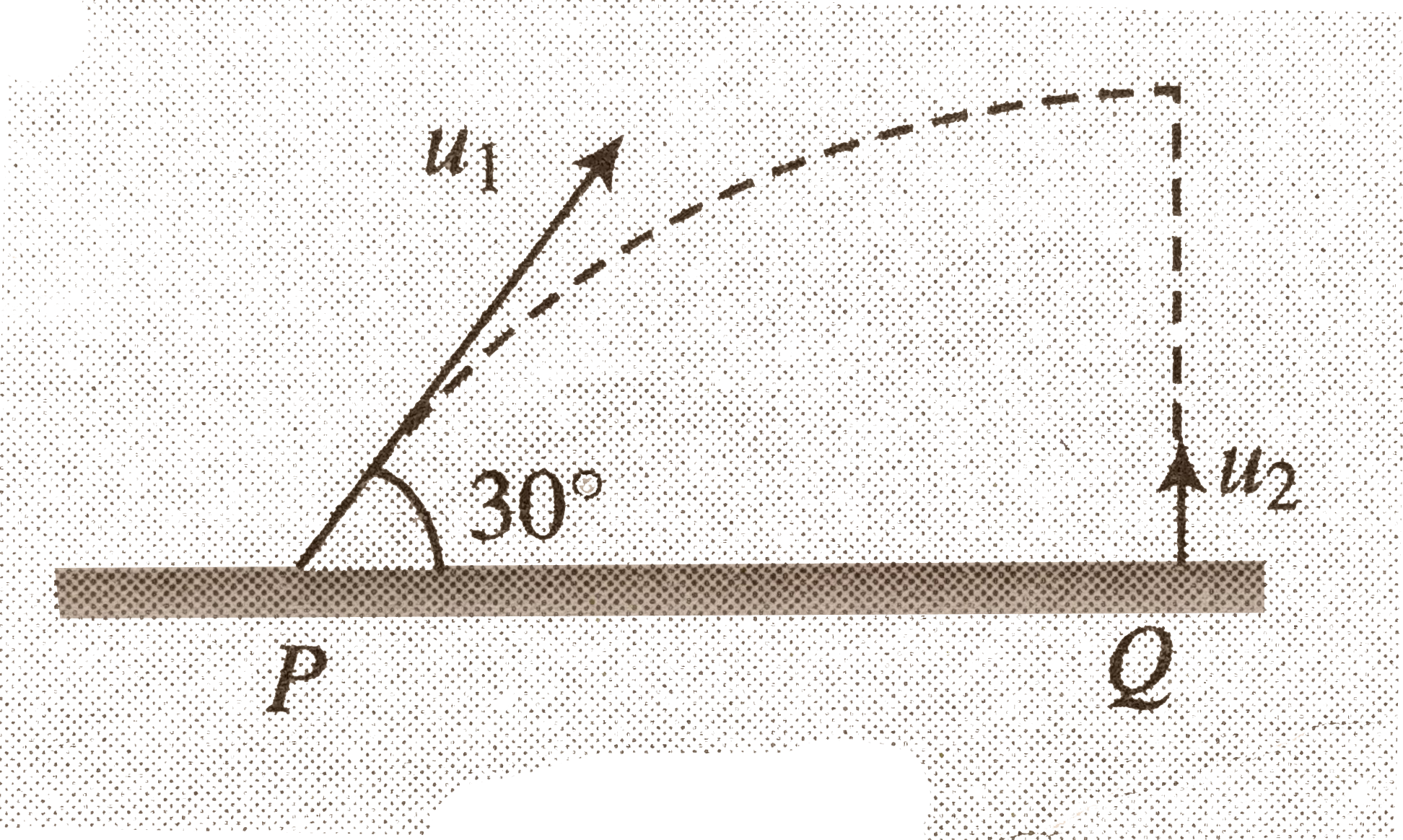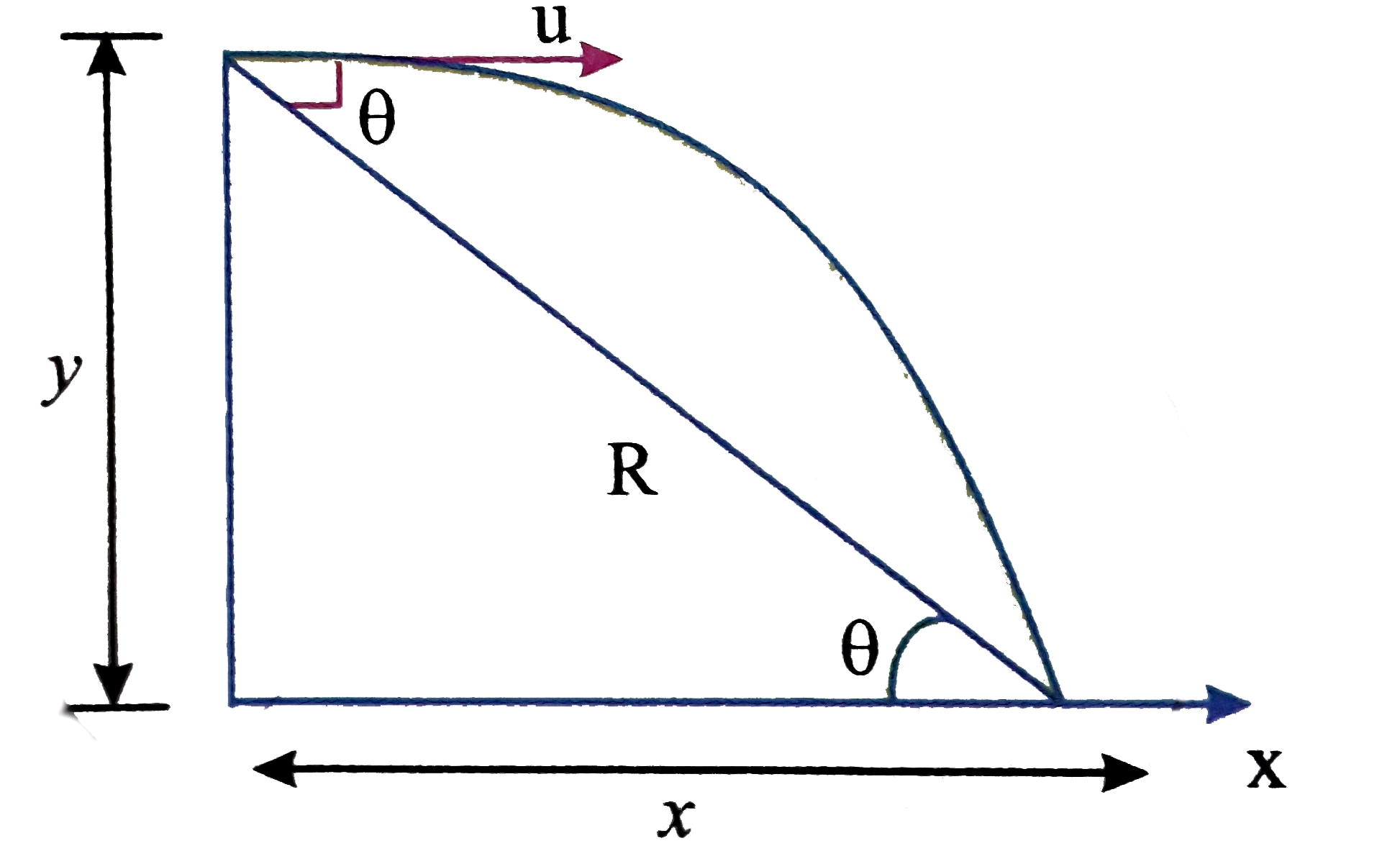A particle A is projected with speed VA from a point making an angle 60∘ with the horizontal. At the same instant, second particle B( lie in the same horizontal plane ) is thrown vertically upwards from a point directly below the maximum height point of parabolic path of A, with velocity VB. If the two particles collide then the ratio of VA/VB should be :
1
2/√3
√3/2
√3
The correct Answer is:B
To solve the problem, we need to analyze the motion of both particles A and B and find the ratio of their velocities when they collide.
1. Understanding the Motion of Particle A:
- Particle A is projected with a speed VA at an angle 60∘ with the horizontal.
- The horizontal and vertical components of the velocity of particle A can be calculated as:
VAx=VAcos(60∘)=VA⋅12=VA2
VAy=VAsin(60∘)=VA⋅√32
2. Finding the Maximum Height of Particle A:
- The maximum height H attained by particle A can be calculated using the formula:
H=V2Ay2g=(VA⋅√32)22g=3V2A8g
3. Understanding the Motion of Particle B:
- Particle B is thrown vertically upwards from a point directly below the maximum height of particle A with an initial velocity VB.
- The height reached by particle B when it collides with particle A is also H.
4. Using the Equations of Motion for Particle B:
- The height H reached by particle B can be expressed as:
H=VBt−12gt2
- Setting the height H from both particles equal gives:
VBt−12gt2=3V2A8g
5. Using the Time of Flight for Particle A:
- The time t taken by particle A to reach the maximum height can be calculated using:
t=VAyg=VA⋅√32g=VA√32g
6. Substituting Time into the Equation for Particle B:
- Substitute t into the height equation for particle B:
H=VB(VA√32g)−12g(VA√32g)2
- Simplifying gives:
H=VBVA√32g−3V2A8g
7. Equating the Heights:
- Set the two expressions for H equal to each other:
3V2A8g=VBVA√32g−3V2A8g
- Rearranging leads to:
3V2A4g=VBVA√32g
8. Finding the Ratio of Velocities:
- Cancel g and VA (assuming VA≠0):
3VA4=VB√32
- Rearranging gives:
VAVB=2√3
Final Ratio:
Thus, the ratio of VA to VB is:
VAVB=2√3
- Particle A is projected with a speed VA at an angle 60∘ with the horizontal.
- The horizontal and vertical components of the velocity of particle A can be calculated as:
VAx=VAcos(60∘)=VA⋅12=VA2
VAy=VAsin(60∘)=VA⋅√32
- The maximum height H attained by particle A can be calculated using the formula:
H=V2Ay2g=(VA⋅√32)22g=3V2A8g
- Particle B is thrown vertically upwards from a point directly below the maximum height of particle A with an initial velocity VB.
- The height reached by particle B when it collides with particle A is also H.
- The height H reached by particle B can be expressed as:
H=VBt−12gt2
- Setting the height H from both particles equal gives:
VBt−12gt2=3V2A8g
- The time t taken by particle A to reach the maximum height can be calculated using:
t=VAyg=VA⋅√32g=VA√32g
- Substitute t into the height equation for particle B:
H=VB(VA√32g)−12g(VA√32g)2
- Simplifying gives:
H=VBVA√32g−3V2A8g
- Set the two expressions for H equal to each other:
3V2A8g=VBVA√32g−3V2A8g
- Rearranging leads to:
3V2A4g=VBVA√32g
- Cancel g and VA (assuming VA≠0):
3VA4=VB√32
- Rearranging gives:
VAVB=2√3
Thus, the ratio of VA to VB is:
VAVB=2√3
Topper's Solved these Questions
- DAILY PRACTICE PROBLEMSBOOK - RESONANCE ENGLISHCHAPTER - DAILY PRACTICE PROBLEMSEXERCISE - dpp 17
7 Videos
- DAILY PRACTICE PROBLEMSBOOK - RESONANCE ENGLISHCHAPTER - DAILY PRACTICE PROBLEMSEXERCISE - dpp 18
7 Videos
- DAILY PRACTICE PROBLEMSBOOK - RESONANCE ENGLISHCHAPTER - DAILY PRACTICE PROBLEMSEXERCISE - dpp 15
8 Videos
- CURRENT ELECTRICITYBOOK - RESONANCE ENGLISHCHAPTER - CURRENT ELECTRICITYEXERCISE - Exercise
53 Videos
- ELASTICITY AND VISCOCITYBOOK - RESONANCE ENGLISHCHAPTER - ELASTICITY AND VISCOCITYEXERCISE - Advanced Level Problems
9 Videos
Similar Questions
A particle A is projected with speed VA from a point making an angle 60∘ with the horizontal. At the same instant, a second particle B is thrown vertically upwards from a point directly below the maximum height point of parabolic path of A, with velocity VB . If the two particles collide then the ratio of VA/VB should be:
View SolutionTwo particle are projected with same initial velocities at an angle 30∘ and 60∘ with the horizontal .Then
View SolutionA particle is projected with a velocity u making an angle θ with the horizontal. At any instant its velocity becomes v which is perpendicular to the initial velocity u. Then v is
View SolutionA particle P is projected with velocity u1 at an angle of 30∘ with the horizontal. Another particle Q is thrown vertically upwards with velocity u2 from a point vertically below the highest point of path of P. Determine the necessary condition for the two particles to collide at the highest point.
 .
.
View SolutionA projectile is thrown upward with a velocity v0 at an angle α to the horizontal. The change in velocity of the projectile when it strikes the same horizontal plane is
View SolutionTwo projectiles thrown from the same point at angles 60∘and30∘ with the horizontal attain the same height. The ratio of their initial velocities is
View SolutionA particle is projected horizontally with a speed u from the top of plane inclined at an angle θ with the horizontal. How far from the point of projection will the particle strike the plane ?

View SolutionA particle is projected with velocity v at an angle θ aith horizontal. The average angle velocity of the particle from the point of projection to impact equals
View SolutionA ball is projected horizontally with a speed v from the top of the plane inclined at an angle 45∘ with the horizontal. How far from the point of projection will the ball strikes the plane?
View SolutionA particle of mass m is projected with a velocity v at an angle of θ with horizontal. The angular momentum of the particle at the highest point of its trajectory is equal to :
View Solution

